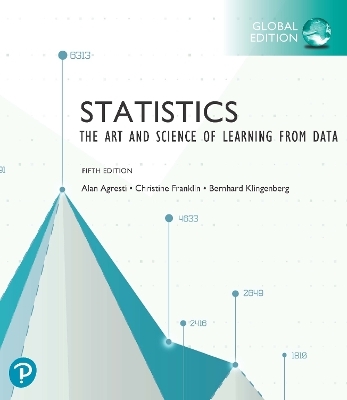
Statistics: The Art and Science of Learning from Data, Global Edition + MyLab Statistics with Pearson eText
Pearson Education Limited
9781292444741 (ISBN)
The art and science of learning from data
Statistics: The Art and Science of Learning from Data takes a conceptual approach,helping students understand what statistics is about and learning the rightquestions to ask when analyzing data, rather than just memorizing procedures.This book takes the ideas that have turned statistics into a central science inmodern life and makes them accessible, without compromising the necessaryrigor. Students will enjoy reading this book, and will stay engaged with itswide variety of real-world data in the examples and exercises.
Alan Agresti is a Distinguished Professor Emeritus in the Department of Statistics at the University of Florida. He taught statistics there for 38 years, including the development of e-courses in statistical methods for social science students and three courses in categorical data analysis. He is the author of more than 100 refereed articles and six texts, including Statistical Methods for the Social Sciences (Pearson, 5th edition, 2018) and An Introduction to Categorical Data Analysis (Wiley, 3rd edition, 2019). Alan has also received teaching awards from the University of Florida and an Excellence in Writing award from John Wiley & Sons. Christine Franklin is the K-12 Statistics Ambassador for the American Statistical Association and elected ASA Fellow. She has retired from the University of Georgia as the Lothar Tresp Honoratus Honors Professor and Senior Lecturer Emerita in Statistics. She is the co-author of two textbooks and has published more than 60 journal articles and book chapters. Chris was the lead writer for the American Statistical Association Pre-K-12 Guidelines for the Assessment and Instruction in Statistics Education (GAISE) Framework document, co-chair for the updated Pre-K-12 GAISE II, and chair of the ASA Statistical Education of Teachers (SET) report. Bernhard Klingenberg is a Professor of Statistics in the Department of Mathematics & Statistics at Williams College, where he has been teaching introductory and advanced statistics classes since 2004. He teaches statistical inference and modelling as well as data visualisation at the Graduate Data Science Program at New College of Florida. Prof. Klingenberg is responsible for the development of the web apps, which he programs using the R package Shiny. A native of Austria, he frequently returns there to hold visiting positions at universities and gives short courses on categorical data analysis in Europe and the United States. He also enjoys photography, with some of his pictures appearing in this book.
PART I: GATHERING AND EXPLORING DATA
Statistics: The Art and Science of Learning from Data
Exploring Data with Graphs and Numerical Summaries
Exploring Relationships Between Two Variables
Gathering Data
PART II: PROBABILITY, PROBABILITY DISTRIBUTIONS, AND SAMPLING DISTRIBUTIONS
Probability in Our Daily Lives
Sampling Distributions
PART III: INFERENTIAL STATISTICS
Statistical Inference: Confidence Intervals
Statistical Inference: Significance Tests About Hypotheses
Comparing Two Groups
PART IV: ANALYZING ASSOCIATION AND EXTENDED STATISTICAL METHODS
Analyzing the Association Between Categorical Variables
Analyzing the Association Between Quantitative Variables: Regression Analysis
Multiple Regression
Comparing Groups: Analysis of Variance Methods
Nonparametric Statistics
| Erscheint lt. Verlag | 16.2.2023 |
|---|---|
| Verlagsort | Harlow |
| Sprache | englisch |
| Maße | 215 x 275 mm |
| Gewicht | 1900 g |
| Themenwelt | Mathematik / Informatik ► Mathematik ► Algebra |
| Mathematik / Informatik ► Mathematik ► Statistik | |
| ISBN-13 | 9781292444741 / 9781292444741 |
| Zustand | Neuware |
| Informationen gemäß Produktsicherheitsverordnung (GPSR) | |
| Haben Sie eine Frage zum Produkt? |
aus dem Bereich

